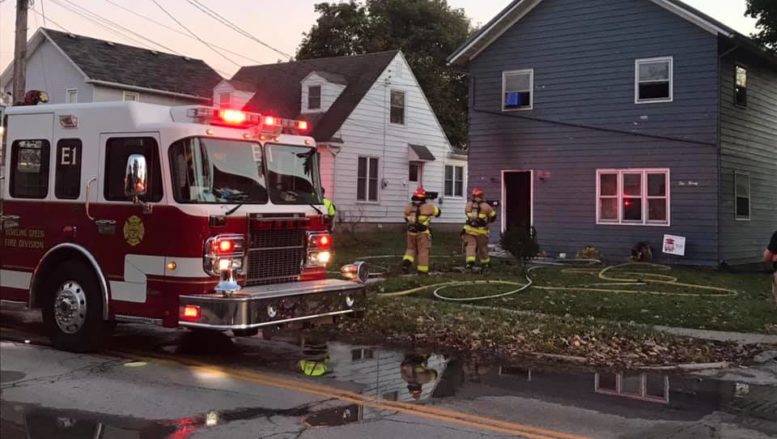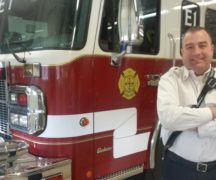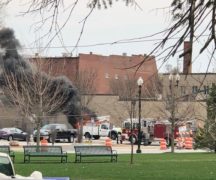By JAN LARSON McLAUGHLIN
BG Independent News
It’s all about the timing.
Six minutes or less is the target for first responders to reach critical patients before they start losing brain cells or heart muscle, and before a fire reaches the point of flashover.
Bowling Green is looking at how to continue quick fire and EMS responses as the number of emergency calls increase and the coverage area grows.
“It’s all about response times,” Bowling Green Fire Chief Bill Moorman said.
A study undertaken by the Ohio Fire Chiefs’ Association has recommended solutions that would maintain the Pearl Street station, move the Court Street station and possibly add a north side station.
The study was prompted by concerns about existing and future response times, by the condition of the East Side fire station, and the city’s attempts to turn the existing station’s location into a “gateway district” between the BGSU campus and downtown area.
New fire stations?
The fire station location analysis identified the best location to construct a new fire station would be near the intersection of East Wooster Street and Mercer Road. The site provides quick access to an east-west thoroughfare, and improves travel times to the eastern and southeastern areas of the city.
The site also provides good access to the downtown area.
A three-station configuration was also considered, with the third station located on North Main Street, somewhere near Industrial Parkway. This would significantly improve travel times to almost all areas of the city, and also position the fire division to meet challenges as the city grows, according to the report.
A more economical option is for the fire division to have one larger station with administrative offices and training rooms, and two smaller satellite stations.
“We don’t want to build three mega stations if we can’t staff or equip them,” Moorman said.
“We want to go on ‘needs’ rather than ‘wants,’” the chief said. “‘Wants’ get expensive.”
No decisions have been made, and a citizens committee will be created to study the issue.
“We’re still in the thinking stage on this,” Moorman said.
Facts gathered by study
The Ohio Fire Chiefs’ Association was contracted to conduct a fire station location analysis for Bowling Green. The 51-page analysis included a community risk assessment and review of the Bowling Green Fire Division’s service delivery and demands for service.
“When it comes to using taxpayer money, we have to make sure we’re doing it right,” Moorman said. “Fire stations aren’t cheap. A fire station is a 50-year investment.”
The fire division has 50 uniformed personnel, with 16 assigned to each of the three shifts, with a maximum daily staffing of 12. The division operates out of two stations: Station 1 at 552 E. Court St., and Station 2 at 1060 Pearl St.
Over the past 10 years, the fire division experienced a 36% increase in calls for service. In 2019, the division responded to 3,504 incidents, with 80% being EMS related.
Over the past 20 years, Bowling Green has experienced residential growth to the west and northern portions of the city. City officials have discussed the need for more residential development, with more starter homes and move-up homes needed to attract young professionals and manufacturing employees.
Industrial growth has occurred to the north, northeast and eastern areas of the city. The city anticipates that continued commercial and industrial growth will occur to the east and northeast as land becomes available.
“We have to look at not only what’s going to serve the citizens today, but what’s going to be the needs in five years, 10 years, 50 years,” Moorman said.
“Where’s it going to serve the most good for everyone,” the chief said.
A risk assessment survey identified 1,355 hazardous properties in the city, with one site rated as a maximum risk and 343 as significant risks. All those properties were plotted on a map.
Travel time maps using GIS mapping and fire analysis software were used to help determine the best locations of future fire stations. With the Pearl Street station staying put, it was determined that the best location for the East Side station would be near the intersection of East Wooster Street and Mercer Road.
The shift of the station further east would lessen the response times to some areas, but lengthen it to others.
“That increased the response time to northern Bowling Green to an unacceptable time,” Moorman said.
So for future planning purposes, a three station configuration was developed. With that model, the best location for the East Side station would move further east, on East Wooster Street between Interstate 75 and Campbell Hill Road. A third station would be added in the area of North Main Street near Industrial Parkway.

Old station
The Court Street fire station was built in 1984 on top of a former landfill, according to the study. The building has experienced significant settling, resulting in large cracks and gaps in concrete block and drywall surfaces, as well as affecting the flow of drains on the second floor. A previously completed structural analysis recommended that the building be razed.
“This was a great location for a station,” Moorman said. “That’s not necessarily the case today.”
The living quarters for firefighters sit directly above the equipment bays. While that used to be a common practice, that is no longer the case since it has been found that the fumes from the bays penetrate the rooms above, Moorman said.
“That’s old school. It’s dangerous, it’s not healthy,” the chief said. “It goes straight into our sleeping quarters.”
Most fire stations built now are single story, which makes it easier for firefighters roused from sleep in the middle of the night. While fire poles and slides were traditional props from the past, they just aren’t safe.
“It’s dangerous,” Moorman said.
Back to the timing issue
The time till help arrives on the scene of an emergency is critical.
The total response time begins when a call for help is received and ends when the dispatched units arrive on the scene.
Time goals for EMS calls are based on research conducted on pre-hospital delivery of medical care and patient outcome and survivability. Quick responses are critical, especially in cardiac arrest situations, because the brain begins to die within 4 to 6 minutes if deprived of oxygen and circulation.
The fire division has established the call handling time benchmark of 1 minute, 4 seconds, for 90% of incidents. The turnout time, between the call and the first unit being enroute to the scene, is 1 minute in 90% of the incidents. The travel time benchmark is 4 minutes – adding up to a total response time of 6 minutes, 4 seconds, for 90% of EMS incidents.
The response times can be lengthened when multiple calls are handled at the same time. This happens more often with EMS runs. In 2019, there were 1,435 incidences of two overlapping calls, and 391 incidences of three or more overlapping calls.
Several factors were evaluated to determine the location to build a new fire station, including travel times and anticipated growth. The study emphasized that land may not be available at the exact location identified. So the best option for the city would be the closest site to the identified location that has sufficient land and is within fair market value.
Travel times identified in the study:
- With the two current fire station sites, much of the city is within 4- and 5-minute travel times. The northeastern and far southeastern areas of the city are beyond 6-minute travel times. The far northwestern and northern areas of the city are within 6-minute and beyond 6 minutes. The developing eastern area, east of I-75, has 4-, 5- and 6-minute travel times.
- If a new East Side station was built in the area of East Wooster and Mercer Road, the travel times would be improved for east of I-75 (4 and 5 minutes) and to the far southeastern areas of the city (5 and 6 minutes). In the most northern area of the city, some areas will have a 5- and 6-minute travel time, and the area beyond a 6-minute travel time is slightly larger
- If the East Side station is moved further east, between Campbell Hill Road and I-75, and a third station is built on North Main Street, the travel times would be significantly improved to the northern, northwestern, eastern and southeastern areas of the city. Most of the city would be within 4-minute travel times and the 5- or 6-minute travel times would be significantly reduced.





